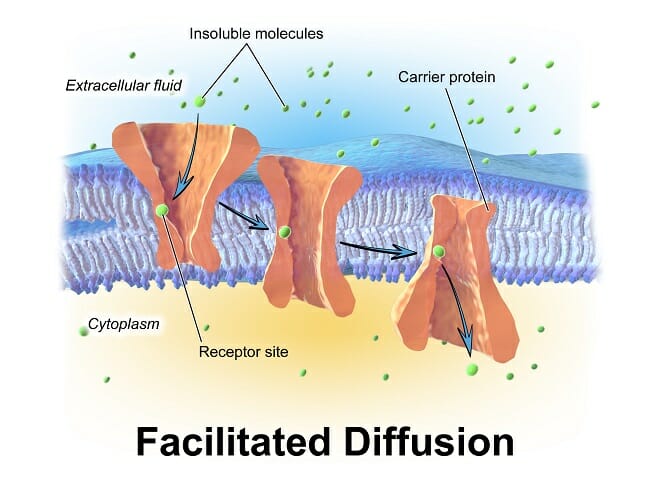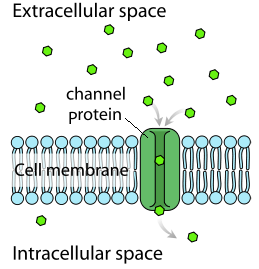Best Describes the Process of Facilitated Diffusion
The movement of molecules through a semi permeable membrane to an area of higher concentration to an area of lower concentration. Facilitated diffusion is a protein-facilitated movement of solutes across a membrane from an area of higher concentration to an area of lower concentration.

Cellular Transport Active Transport Biology Passive Transport Medical Assistant Student
Therefore diffusion is considered a type of.

. Secondary active transport requires an input of energy while facilitated diffusion does not. Which of the following best describes the process of facilitated diffusion. The molecule is released on the other side of the membrane.
Facilitated diffusion is the process in which molecules pass across the. Facilitated diffusion also known as facilitated transport or passive-mediated transport is the process of spontaneous passive transport as opposed to active transport of molecules or ions across a biological membrane via specific transmembrane integral proteins. A Receptor-mediated endocytosis B Phagocytosis C Pinocytosis D Exocytosis E Co-transport.
Facilitated diffusion requires an input of energy while secondary active transport does not. Diffusion is the process of spreading something more widely. Facilitated diffusion is a biological transport process in which specific structural components of biological membranes interact with specific solutes or classes of solutes significantly increasing their rates of crossing the membrane.
A Osmosis B Diffusion C Facilitated diffusion D Active transport E None of the above 27 Which of the following best describes the transport process occurring in the diagram above. The carrier protein changes shape shielding the molecule from the interior of the membrane. What are the three main steps of facilitated diffusion.
Passive movement of solutes across a membrane down their concentration gradients with the involvement of membrane proteins A Calorie displayed on the nutritional label of a candy bar is equal to. What process best describes the SGLT. Which best describes the process of diffusion.
Simple diffusion occurs through the phospholipid bilayer. Which of the following best describes facilitated diffusion. Facilitated diffusion also known as facilitated transport or passive-mediated transport is the process of spontaneous passive transport as opposed to active transport of molecules or ions across a biological membrane via specific transmembrane integral proteins.
Facilitated diffusion is the transport of substances across a biological membrane through a concentration gradient by means of a carrier molecule. Facilitated diffusion is a process of passive transport where molecules diffuse across membrane. A molecule bonds to a carrier.
The movement of molecules through a semi permeable membrane from an area of lower concentration to an area of higher concentration. Match each pair of solutions to the net direction the water will flow between the two solutions. Facilitated diffusion occurs through transmembrane proteins.
A process mediated by ATP synthase pumps protons against their concentration gradient C. Give examples of each. What best describes facilitated diffusion.
Which of the following technological innovations facilitated indian ocean commerce. Distinguish between monosaccharides disaccharides and polysaccharides. Like simple diffusion facilitated diffusion doesnt require metabolic energy and simply occurs across the concentration gradient.
Movement of a solute down its concentration gradient with the help of membrane proteins What is the important structural difference between rough endoplasmic reticulum ER and smooth ER. Facilitated diffusion is the diffusion of solutes through transport proteins in the plasma membrane. The carrier protein then returns to its original shape.
Facilitated diffusion is a type of passive transport. Which of the following statements best describes the difference between facilitated diffusion and secondary active transport. 3 Facilitated diffusion is a type of passive transport in which ionsmolecules cross the semi permeable membrane because permeases present in the membrane facilitate the transport.
Which of the following best describes the process of facilitated diffusion. Which of the following best describes the process of facilitated diffusion. Facilitated diffusion of protons down an electrochemical gradient releases energy that is used in the synthesis of ATP from ADP and Pl Facilitated diffusion of protons down an.
View Test Prep - chap 2 bio lab 2 answers from BIOL 121 at Springfield College. Facilitated diffusion differs from simple diffusion in that facilitated diffusion _____. Diffusion is the process by which particles tend to move from an area where they are more concentrated to an area where they are less concentrated.
Diffusion does not require the cell to expend atp. Simple diffusion facilitated diffusion active transport or secondary active transport Use the book to complete this tableChemical Digestion Absorption Enzyme Name Where is it Where. It can be the diffusion of Homo Sapiens from the plains of Africa the diffusion of a drop of ink in a bucket of water diffusion of the use of smart phones.
The difference between diffusion and facilitated diffusion is that. The process by which NADH produced in glycolysis is transported into the mitochondrion b. The movement of molecules across a semi permeable membrane until there are equal.
Which best describes the process of facilitated diffusion across a cell membrane. Even though facilitated diffusion involves transport proteins it is still passive transport because the solute is moving down the concentration.

Facilitated Diffusion Definition Examples Quiz Biology Dictionary


No comments for "Best Describes the Process of Facilitated Diffusion"
Post a Comment